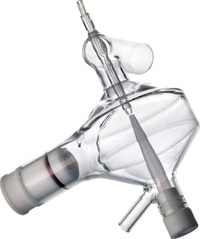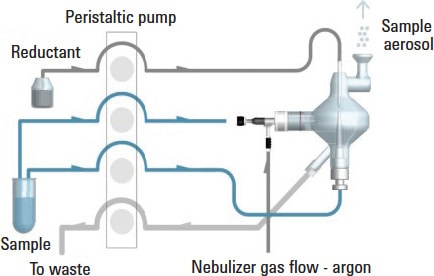Access Agilent eNewsletter May 2016

Improved efficiency in routine analysis of hydride and non-hydride elements using Agilent MSIS
Alejandro Amorin, Agilent Technical Marketing Engineer
Analysts routinely use vapor generation techniques for trace level analysis of arsenic (As), selenium (Se), and other hydride forming elements, and the cold vapor method for analysis of mercury (Hg), in water and environmental samples. These techniques have advantages that include improved sensitivity, simplicity, and reduced interferences. But to use the hydride technique, you must dedicate an instrument or shut it down to make the change. You cannot perform another type of determination until you reconfigure the instrument again. The Agilent Multimode Sample Introduction System (MSIS) overcomes this disruptive, time-consuming limitation.

Figure 1. The Agilent MSIS enables simultaneous determination of routine and hydride elements using the same setup, which saves time and effort.
Unique MSIS eliminates change-over and enables simultaneous hydride analysis
The Multimode Sample Introduction System is used with the Agilent ICP-OES and other manufacturers’ ICP-OES instruments to enable determination with conventional nebulization, vapor generation, or both at the same time. [1,2] The sample is introduced simultaneously through the nebulizer and pumped through the base of the MSIS, where it is mixed with the reductant in a thin film to generate the volatile hydride species.
The MSIS eliminates the need to shut down an instrument to swap between a spray chamber and a vapor generation accessory. Use of the MSIS for simultaneous hydride generation also eliminates the need for a second sample digest specifically for hydride determinations.
Simultaneous determination of hydride and non-hydride elements in water samples
To demonstrate, we used the Agilent MSIS with the PerkinElmer Optima 7300 DV ICP-OES to simultaneously determine mercury plus selected hydride-forming and non-hydride elements in a certified water sample (NIST SRM 1643f). We used only Agilent supplies for the PerkinElmer Optima ICP-OES instrument.

Figure 2. An Agilent MSIS configured for simultaneous hydride generation and conventional nebulization is convenient and economical.
When the Agilent MSIS is configured for simultaneous analysis, you must pump four solutions, including one to waste (Figure 2), so we used a stand-alone external peristaltic pump to provide extra capacity.
Sample preparation consisted of 1:2 dilution with concentrated hydrochloric acid. This matrix provides good recoveries for the hydride-forming elements. [3] The reductant was 1% (w/v) sodium borohydride (NaBH4) in 0.5% (w/v) sodium hydroxide (NaOH). We prepared calibration standards from Agilent single-element standards and matrix-matched them in 50% hydrochloric acid. Standard concentrations bracketed the elemental concentrations in the certified water sample. The most concentrated standard contained 25 ug/L V, 500 ug/L Mg/Ca, 100 ug/L As, 25 ug/L Se/Hg, and 250 ug/L for all of the other elements.
Excellent detection limits, recoveries, and precision
Table 1 compares the detection limits using the MSIS in simultaneous mode with those obtained using conventional nebulization. The detection limits for As, Se, and Hg using vapor generation were improved to low-ppb levels. The detection limits for the other elements were equivalent to those achieved with conventional nebulization.
| Element and wavelength (nm) | Measured using inert OneNeb nebulizer in nebulization mode µg/L | Measured using inert OneNeb nebulizer in simultaneous mode µg/L |
|---|---|---|
| Al 394.401 | 4 | 8 |
| As 193.696 | 13 | 1.7* |
| Ca 317.933 | 0.4 | 3.3 |
| Cd 226.502 | 0.1 | 0.24 |
| Co 230.786 | 0.2 | 1.0 |
| Cr 357.869 | 2.0 | 6.9 |
| Cu 324.752 | 0.5 | 2.1 |
| Fe 259.939 | 1.5 | 1.5 |
| Hg 194.168 | 1.3 | 0.23* |
| Li 670.784 | 0.04 | 0.03 |
| Mg 279.553 | 0.1 | 0.35 |
| Mn 257.610 | 0.04 | 0.3 |
| Mo 204.597 | 1.2 | 1.7 |
| Ni 341.476 | 4 | 11 |
| Pb 220.353 | 3.0 | 3.7 |
| Se 196.026 | 12.0 | 0.3* |
| V 292.402 | 0.4 | 1.5 |
| Zn 202.548 | 0.1 | 0.42 |
* Measured using hydride determination
Table 1. Detection limits achieved using the Agilent MSIS in simultaneous mode with the PerkinElmer Optima 7300 DV ICP-OES were equivalent to those observed using conventional nebulization.
Although sample concentrations in NIST SRM 1643f spanned four orders of magnitude, we obtained good recoveries with simultaneous analysis of 18 elements, including Hg, As, and Se (Table 2). We achieved excellent precision for most elements, with less than 1% RSD for low-concentration calibration standards of 0.25 mg/L and below. To further assess accuracy, we spiked an aliquot of the NIST SRM 1643f with the hydride elements. Recoveries for the low-concentration spike ranged from 98 to almost 100% (Table 3).
| Element and wavelength (nm) | Measured concentration µg/L | Certified value for NIST SRM 1643f µg/L | Recovery (%) |
|---|---|---|---|
| Al 394.401 | 128.4 | 133.8 ± 1.2 | 96 |
| As* 188.979 | 58.09 | 57.42 ± 0.38 | 101 |
| Ca 422.673 | 31,064 | 29,430 ± 330 | 106 |
| Cd 226.502 | 5.78 | 5.89 ± 0.13 | 98 |
| Co 228.616 | 26.5 | 25.3 ± 0.17 | 105 |
| Cr 357.869 | 18.5 | 18.5 ± 0.10 | 100 |
| Cu 324.752 | 23.13 | 21.66 ± 0.71 | 107 |
| Fe 259.939 | 97.50 | 93.44 ± 0.78 | 104 |
| Li 670.784 | 15.28 | 16.59 ± 0.35 | 92 |
| Mg 279.553 | 7,387 | 7,454 ± 60 | 99 |
| Mn 257.610 | 38.21 | 37.14 ± 0.60 | 103 |
| Mo 204.597 | 119.1 | 115.3 ± 1.7 | 103 |
| Ni 341.476 | 58.7 | 59.8 ± 1.4 | 98 |
| Pb 220.353 | 17.676 | 18.488 ± 0.084 | 96 |
| Se* 196.026 | 10.814 | 11.700 ± 0.081 | 92 |
| V 292.402 | 38.31 | 36.07 ± 0.28 | 106 |
| Zn 202.548 | 75.1 | 74.4 ± 1.7 | 101 |
* Measured using hydride determination
Table 2. Good recoveries for 18 elements determined in NIST water SRM 1643f with the Agilent MSIS in simultaneous mode.
| NIST SRM | % Recovery | ||
|---|---|---|---|
| As 188.979 nm | Hg 194.168 nm | Se 196.026 nm | |
| 1643f Trace elements in water | 99.5 | 97.8 | 98.7 |
Table 3. Excellent spike recoveries for low-concentration spike of the NIST water SRM 1643f.
Measure hydride and non-hydride elements simultaneously with confidence
The Agilent Multimode Sample Introduction System provides good precision, wide dynamic range, and low detection limits when used for simultaneous determination of non-hydride and hydride elements. It eliminates the need to shut down the instrument to swap between a spray chamber and a vapor generation accessory, so you save set-up time. And you no longer need a second sample digest, specifically for hydride determinations.
You can use the Agilent MSIS with both Agilent and other manufacturers’ ICP-OES instruments. To learn more, download Agilent publication 5991-6509EN. Then explore the portfolio of Agilent supplies for the PerkinElmer AA, ICP-OES, and ICP-MS instruments.
References
- Roger McLaughlin, Paula Cheese, Min Ding, Adam Ptolemy, April Conn, and Ian Brindle, “A Convenient Sample Introduction System for ICP, ICP-MS, and AA,” American Laboratory article (2006).
- Gaurav Kapadnis, Vinay Jain, and Samir Vyas, “Determination of elements in drinking water as per Bureau of Indian Standards 10500, 14543 & 13428 using the Agilent 5100 ICP-OES,” Agilent Application Note 5991-6631EN (2015).
- J. Cauduro, “Simultaneous analysis of hydride and non-hydride-forming elements via ICP-OES,” Agilent White Paper 5991-6445EN.
Stay informed about the applications that are important to you
Subscribe to Access Agilent
Our free customized
monthly eNewsletter
All articles in this issue
 Detailed analysis of therapeutic proteins with Agilent 1290 Infinity II 2D-LC Solution
Detailed analysis of therapeutic proteins with Agilent 1290 Infinity II 2D-LC Solution Agilent AdvanceBio SEC delivers optimal performance regardless of instrument
Agilent AdvanceBio SEC delivers optimal performance regardless of instrument Quick, accurate pesticide analysis in foods using Agilent J&W DB-35ms Ultra Inert GC columns
Quick, accurate pesticide analysis in foods using Agilent J&W DB-35ms Ultra Inert GC columns Agilent Mini-QuEChERS and HES provide robustness and cost-savings in GC/MS/MS pesticide analysis of foods
Agilent Mini-QuEChERS and HES provide robustness and cost-savings in GC/MS/MS pesticide analysis of foods Agilent OpenLAB Electronic Lab Notebook gives biopharma company a competitive edge
Agilent OpenLAB Electronic Lab Notebook gives biopharma company a competitive edge Improved efficiency in routine analysis of hydride and non-hydride elements using Agilent MSIS
Improved efficiency in routine analysis of hydride and non-hydride elements using Agilent MSIS Maximize lab productivity and results consistency with Agilent SQ Walkup Solution
Maximize lab productivity and results consistency with Agilent SQ Walkup Solution Agilent Automated Purification Solutions help researchers to purify complex compounds
Agilent Automated Purification Solutions help researchers to purify complex compounds
Figure 2

An Agilent MSIS configured for simultaneous hydride generation and conventional nebulization is convenient and economical.